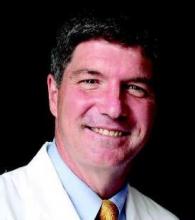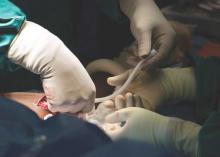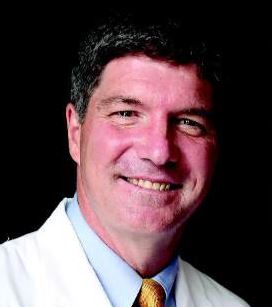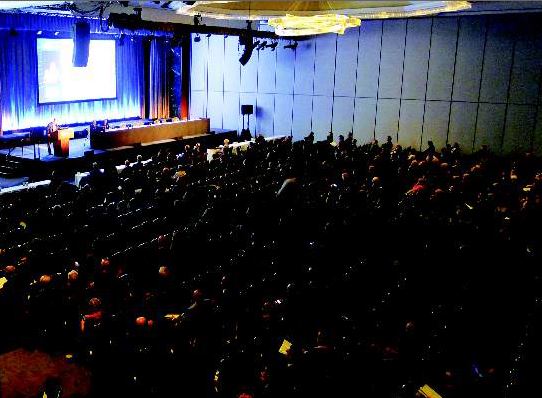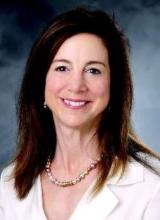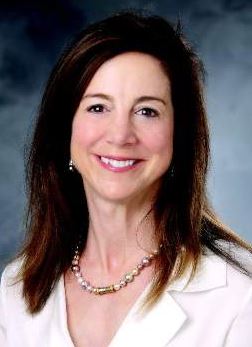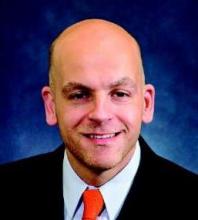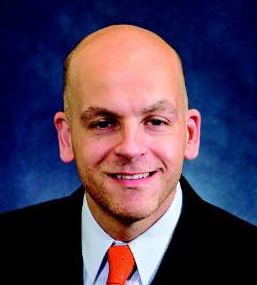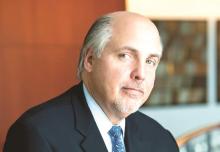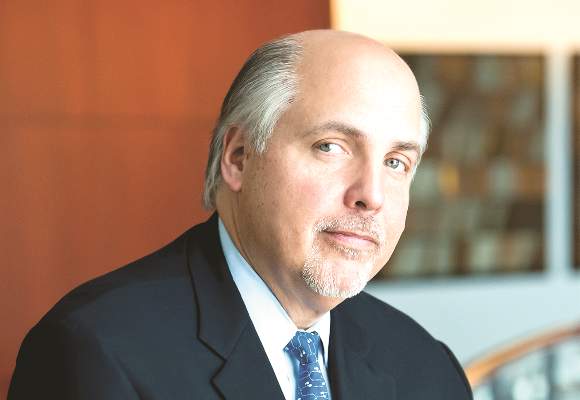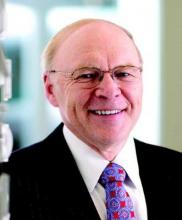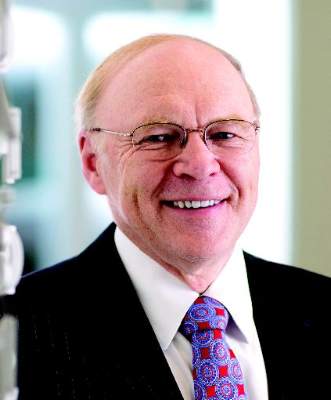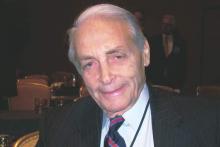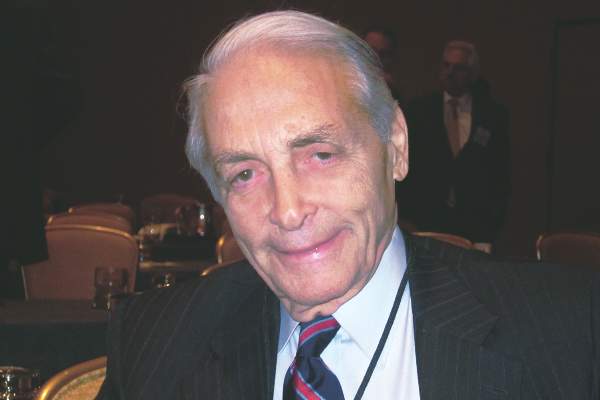User login
Human Tissue Bioengineered Vessels: Welcome to the Future
No indication of an immune response or structural failure was apparent at 6-month follow-up in the first-in-man trial of human tissue engineered vessels, according to Dr. Jeffrey H. Lawson. Dr. Lawson will discuss the current status of the bioengineered vascular tissue in his presentation entitled “Human Tissue Engineered Arterial Grafts Are Finally Working as Lower Extremity Bypasses and Dialysis Access: Why and Prospects for the Future.”
In collaboration with Dr. Laura Niklason, professor of anesthesia and biomedical engineering at Yale University School of Bioengineering and Applied Science, and Humacyte co-founder, Dr. Lawson, a vascular surgeon and professor of surgery at Duke University School of Medicine, Durham, N.C., has been instrumental in the development of the investigational human acellular vessel (HUMACYL, Humacyte, Inc.), and now serves as chief medical officer for Humacyte.
The device was developed to provide vascular access for patients with end-stage renal disease who require hemodialysis, and also has potential utility for reconstruction of arteries and vessels throughout the body, said Dr. Lawson, who also is vice-chair of research for the department of surgery at Duke.
The HUMACYL device has received fast-track designation by the Food and Drug Administration, and is in ongoing phase II trials in the United States and Europe. A global phase III study is planned in the coming months.
Dr. Lawson will review some of the key milestones from the pre-clinical and Phase II human trials.
The HUMACYL device is an implantable blood vessel engineered from donor vascular cells. The technology has evolved from early prototypes more than 2 decades ago to implantation in humans in the currently ongoing trials, he said.
The device, built upon a biodegradable polymer scaffold to guide tissue shape, involves the use of polyglycolic acid that is woven into a tube seeded with vascular smooth muscle cells. The initial scaffold degrades, leaving a blood vessel made implantable following removal of the original cellular antigens. This acellular structure allows incorporation of host cells, Dr. Lawson explained.
Trial, error and systematic science have led to the development of a more robust structure, with good suture retention and integrity.
In an ongoing open label, single-arm clinical trial, 6-month follow-up is currently available for the last of the implanted patients from three sites in Poland and three sites in the United States.
The device was used in these patients – end-stage renal disease patients who were not candidates for fistula creation – to provide upper arm arteriovenous access for hemodialysis. It was was used for dialysis between 4 and 8 weeks following implantation, and patients were monitored with monthly clinical evaluations and ultrasound for the first 6 months, and were followed for up to 2 years.
Dr. Lawson will discuss the findings in detail, but noted that initial data in 28 patients showed 100% secondary patency, and the 6-month findings showed no indication of immune response, no evidence of structural failure, no change in panel reactive antibody class 1 reactivity, and flow rates suitable for dialysis.
The phase III pivotal trial is being designed, he said, noting that the initial approval will be sought for use in the area of vascular access for dialysis.
The device also has potential use for reconstruction anywhere in the body; pre-clinical testing has been done in coronary and small-caliber arterial positions, Dr. Lawson said.
“The opportunities are endless. There is no reason to think we couldn’t make this tissue for arterial and/or venous use, anywhere in the body. We have experienced success with implantation in both animals and humans, with no immune rejection,” he said, adding that robust cellular re-population and good structural stability have been noted.
The exciting findings with respect to the HUMACYL device, which demonstrate that off-the-shelf bioengineered vascular tissues are possible, are non-immunogenic, and integrate with native tissues and repopulate and remodel, increasing in strength after implantation while having little intimal hyperplasia, are just the beginning, he said. The findings, he said, set the groundwork for more complex tissues to be developed in the future.
“This could make it possible for us to grow organs and other structures that are needed throughout the body,” he said.
Dr. Lawson has received consulting fees and research funding from Humacyte.
Session 47: New Techniques, Technology and Concepts
Human Tissue Engineered Arterial Grafts Are Finally Working as Lower Extremity Bypasses and Dialysis Access: Why and Prospects for the Future
7:27 a.m. – 7:32 a.m.
No indication of an immune response or structural failure was apparent at 6-month follow-up in the first-in-man trial of human tissue engineered vessels, according to Dr. Jeffrey H. Lawson. Dr. Lawson will discuss the current status of the bioengineered vascular tissue in his presentation entitled “Human Tissue Engineered Arterial Grafts Are Finally Working as Lower Extremity Bypasses and Dialysis Access: Why and Prospects for the Future.”
In collaboration with Dr. Laura Niklason, professor of anesthesia and biomedical engineering at Yale University School of Bioengineering and Applied Science, and Humacyte co-founder, Dr. Lawson, a vascular surgeon and professor of surgery at Duke University School of Medicine, Durham, N.C., has been instrumental in the development of the investigational human acellular vessel (HUMACYL, Humacyte, Inc.), and now serves as chief medical officer for Humacyte.
The device was developed to provide vascular access for patients with end-stage renal disease who require hemodialysis, and also has potential utility for reconstruction of arteries and vessels throughout the body, said Dr. Lawson, who also is vice-chair of research for the department of surgery at Duke.
The HUMACYL device has received fast-track designation by the Food and Drug Administration, and is in ongoing phase II trials in the United States and Europe. A global phase III study is planned in the coming months.
Dr. Lawson will review some of the key milestones from the pre-clinical and Phase II human trials.
The HUMACYL device is an implantable blood vessel engineered from donor vascular cells. The technology has evolved from early prototypes more than 2 decades ago to implantation in humans in the currently ongoing trials, he said.
The device, built upon a biodegradable polymer scaffold to guide tissue shape, involves the use of polyglycolic acid that is woven into a tube seeded with vascular smooth muscle cells. The initial scaffold degrades, leaving a blood vessel made implantable following removal of the original cellular antigens. This acellular structure allows incorporation of host cells, Dr. Lawson explained.
Trial, error and systematic science have led to the development of a more robust structure, with good suture retention and integrity.
In an ongoing open label, single-arm clinical trial, 6-month follow-up is currently available for the last of the implanted patients from three sites in Poland and three sites in the United States.
The device was used in these patients – end-stage renal disease patients who were not candidates for fistula creation – to provide upper arm arteriovenous access for hemodialysis. It was was used for dialysis between 4 and 8 weeks following implantation, and patients were monitored with monthly clinical evaluations and ultrasound for the first 6 months, and were followed for up to 2 years.
Dr. Lawson will discuss the findings in detail, but noted that initial data in 28 patients showed 100% secondary patency, and the 6-month findings showed no indication of immune response, no evidence of structural failure, no change in panel reactive antibody class 1 reactivity, and flow rates suitable for dialysis.
The phase III pivotal trial is being designed, he said, noting that the initial approval will be sought for use in the area of vascular access for dialysis.
The device also has potential use for reconstruction anywhere in the body; pre-clinical testing has been done in coronary and small-caliber arterial positions, Dr. Lawson said.
“The opportunities are endless. There is no reason to think we couldn’t make this tissue for arterial and/or venous use, anywhere in the body. We have experienced success with implantation in both animals and humans, with no immune rejection,” he said, adding that robust cellular re-population and good structural stability have been noted.
The exciting findings with respect to the HUMACYL device, which demonstrate that off-the-shelf bioengineered vascular tissues are possible, are non-immunogenic, and integrate with native tissues and repopulate and remodel, increasing in strength after implantation while having little intimal hyperplasia, are just the beginning, he said. The findings, he said, set the groundwork for more complex tissues to be developed in the future.
“This could make it possible for us to grow organs and other structures that are needed throughout the body,” he said.
Dr. Lawson has received consulting fees and research funding from Humacyte.
Session 47: New Techniques, Technology and Concepts
Human Tissue Engineered Arterial Grafts Are Finally Working as Lower Extremity Bypasses and Dialysis Access: Why and Prospects for the Future
7:27 a.m. – 7:32 a.m.
No indication of an immune response or structural failure was apparent at 6-month follow-up in the first-in-man trial of human tissue engineered vessels, according to Dr. Jeffrey H. Lawson. Dr. Lawson will discuss the current status of the bioengineered vascular tissue in his presentation entitled “Human Tissue Engineered Arterial Grafts Are Finally Working as Lower Extremity Bypasses and Dialysis Access: Why and Prospects for the Future.”
In collaboration with Dr. Laura Niklason, professor of anesthesia and biomedical engineering at Yale University School of Bioengineering and Applied Science, and Humacyte co-founder, Dr. Lawson, a vascular surgeon and professor of surgery at Duke University School of Medicine, Durham, N.C., has been instrumental in the development of the investigational human acellular vessel (HUMACYL, Humacyte, Inc.), and now serves as chief medical officer for Humacyte.
The device was developed to provide vascular access for patients with end-stage renal disease who require hemodialysis, and also has potential utility for reconstruction of arteries and vessels throughout the body, said Dr. Lawson, who also is vice-chair of research for the department of surgery at Duke.
The HUMACYL device has received fast-track designation by the Food and Drug Administration, and is in ongoing phase II trials in the United States and Europe. A global phase III study is planned in the coming months.
Dr. Lawson will review some of the key milestones from the pre-clinical and Phase II human trials.
The HUMACYL device is an implantable blood vessel engineered from donor vascular cells. The technology has evolved from early prototypes more than 2 decades ago to implantation in humans in the currently ongoing trials, he said.
The device, built upon a biodegradable polymer scaffold to guide tissue shape, involves the use of polyglycolic acid that is woven into a tube seeded with vascular smooth muscle cells. The initial scaffold degrades, leaving a blood vessel made implantable following removal of the original cellular antigens. This acellular structure allows incorporation of host cells, Dr. Lawson explained.
Trial, error and systematic science have led to the development of a more robust structure, with good suture retention and integrity.
In an ongoing open label, single-arm clinical trial, 6-month follow-up is currently available for the last of the implanted patients from three sites in Poland and three sites in the United States.
The device was used in these patients – end-stage renal disease patients who were not candidates for fistula creation – to provide upper arm arteriovenous access for hemodialysis. It was was used for dialysis between 4 and 8 weeks following implantation, and patients were monitored with monthly clinical evaluations and ultrasound for the first 6 months, and were followed for up to 2 years.
Dr. Lawson will discuss the findings in detail, but noted that initial data in 28 patients showed 100% secondary patency, and the 6-month findings showed no indication of immune response, no evidence of structural failure, no change in panel reactive antibody class 1 reactivity, and flow rates suitable for dialysis.
The phase III pivotal trial is being designed, he said, noting that the initial approval will be sought for use in the area of vascular access for dialysis.
The device also has potential use for reconstruction anywhere in the body; pre-clinical testing has been done in coronary and small-caliber arterial positions, Dr. Lawson said.
“The opportunities are endless. There is no reason to think we couldn’t make this tissue for arterial and/or venous use, anywhere in the body. We have experienced success with implantation in both animals and humans, with no immune rejection,” he said, adding that robust cellular re-population and good structural stability have been noted.
The exciting findings with respect to the HUMACYL device, which demonstrate that off-the-shelf bioengineered vascular tissues are possible, are non-immunogenic, and integrate with native tissues and repopulate and remodel, increasing in strength after implantation while having little intimal hyperplasia, are just the beginning, he said. The findings, he said, set the groundwork for more complex tissues to be developed in the future.
“This could make it possible for us to grow organs and other structures that are needed throughout the body,” he said.
Dr. Lawson has received consulting fees and research funding from Humacyte.
Session 47: New Techniques, Technology and Concepts
Human Tissue Engineered Arterial Grafts Are Finally Working as Lower Extremity Bypasses and Dialysis Access: Why and Prospects for the Future
7:27 a.m. – 7:32 a.m.
Online Conference Library Available After Meeting
For 42 years, the latest pharmacologic, radiologic, surgical, and endovascular techniques and technologies have been presented at the VEITHsymposium, along with discussions of when these treatments are indicated. Updates on clinical trials and opportunities for dialogue with experts in the field provide insight along with the latest results of the various treatment modalities.
This information is packed into a single meeting with as many short presentations as possible – many of them concurrent. Access has been facilitated by providing electronically archived material, including talks and slides, after the meeting.
To avoid the conundrum of having to choose between concurrent sessions, meeting attendees can access them through this year’s online library, which can be found at www.veithondemand.com. For individuals unable to attend the meeting, the online library is CME accredited so that they may receive credit for their educational viewing experience.
VEITHsymposium has partnered with Edge Creek Media, Inc. to digitally capture the presentations from this year’s event and make them available online for cross-platform and mobile device viewing. Each webcast presentation will be produced with synchronous presenter audio, and slide content to illustrate the talks.
The online library will contain more than 1300 webcast presentations and will include presentations from the almost 600 expert speakers. This library will recreate the remarkable educational experience of attending in person. It will also provide an invaluable resource of ongoing vascular information.
Edge Creek Media is a specialized multimedia production company that offers custom live event recording and webcast streaming solutions. Other core services include mobile app development, live event production, audio/video post production, and multimedia web development.
For more information, visit www.edgecreekmedia.com or contact the company at [email protected].
For 42 years, the latest pharmacologic, radiologic, surgical, and endovascular techniques and technologies have been presented at the VEITHsymposium, along with discussions of when these treatments are indicated. Updates on clinical trials and opportunities for dialogue with experts in the field provide insight along with the latest results of the various treatment modalities.
This information is packed into a single meeting with as many short presentations as possible – many of them concurrent. Access has been facilitated by providing electronically archived material, including talks and slides, after the meeting.
To avoid the conundrum of having to choose between concurrent sessions, meeting attendees can access them through this year’s online library, which can be found at www.veithondemand.com. For individuals unable to attend the meeting, the online library is CME accredited so that they may receive credit for their educational viewing experience.
VEITHsymposium has partnered with Edge Creek Media, Inc. to digitally capture the presentations from this year’s event and make them available online for cross-platform and mobile device viewing. Each webcast presentation will be produced with synchronous presenter audio, and slide content to illustrate the talks.
The online library will contain more than 1300 webcast presentations and will include presentations from the almost 600 expert speakers. This library will recreate the remarkable educational experience of attending in person. It will also provide an invaluable resource of ongoing vascular information.
Edge Creek Media is a specialized multimedia production company that offers custom live event recording and webcast streaming solutions. Other core services include mobile app development, live event production, audio/video post production, and multimedia web development.
For more information, visit www.edgecreekmedia.com or contact the company at [email protected].
For 42 years, the latest pharmacologic, radiologic, surgical, and endovascular techniques and technologies have been presented at the VEITHsymposium, along with discussions of when these treatments are indicated. Updates on clinical trials and opportunities for dialogue with experts in the field provide insight along with the latest results of the various treatment modalities.
This information is packed into a single meeting with as many short presentations as possible – many of them concurrent. Access has been facilitated by providing electronically archived material, including talks and slides, after the meeting.
To avoid the conundrum of having to choose between concurrent sessions, meeting attendees can access them through this year’s online library, which can be found at www.veithondemand.com. For individuals unable to attend the meeting, the online library is CME accredited so that they may receive credit for their educational viewing experience.
VEITHsymposium has partnered with Edge Creek Media, Inc. to digitally capture the presentations from this year’s event and make them available online for cross-platform and mobile device viewing. Each webcast presentation will be produced with synchronous presenter audio, and slide content to illustrate the talks.
The online library will contain more than 1300 webcast presentations and will include presentations from the almost 600 expert speakers. This library will recreate the remarkable educational experience of attending in person. It will also provide an invaluable resource of ongoing vascular information.
Edge Creek Media is a specialized multimedia production company that offers custom live event recording and webcast streaming solutions. Other core services include mobile app development, live event production, audio/video post production, and multimedia web development.
For more information, visit www.edgecreekmedia.com or contact the company at [email protected].
A Worldwide Focus On Carotid Disease and Treatment Options
Wednesday’s Worldwide Podium presentations are part of the Associate Faculty Program at VEITHsymposium, dedicated to featuring research by up-and-coming and lesser known researchers from around the world, excluding Latin America and Asia. Several exciting papers on treating carotid disease will be featured in the morning program.
Symptomatic carotid artery disease risks a futher debilitating event, and in order to best manage the patient, local and international guidelines recommend that a procedure be done within 2 weeks of an initial event in order to gain maximal benefit, according to Dr. Kalpa Perera of Eastern Health in Melbourne, Australia, and colleagues.
Dr. Perera will present the results of a single-center retrospective audit of all cases of symptomatic carotid artery disease that underwent carotid endarterectomy (CEA) over a 1-year period, examining the timing data to treatment.
Of 40 patients included, 30 (75%) had their procedure completed within the recommended 2-week timeframe. All cases done within the guidelines were inpatients. In direct contrast, Dr. Perera and his colleagues found that 8 of the 10 patients operated on after 2 weeks were outpatient referrals.
This, according to Dr. Perera “suggests that there may be some unnecessary delays in outpatient referrals and there is scope for improvement.”
Dr. Ignazio Leal, of Complejo Hospitalario De Toledo, Spain, will present a prospective study that evaluated the outcomes of performing a staged transcervical carotid artery stenting (CAS) prior to the use of a flow-reversal method of coronary artery bypass grafting (CABG). The study examined the incidence of myocardial infarction (MI), perioperative stroke, and death at 30 days after intervention.
All of the patients in the study had concomitant severe carotid disease at high risk for endarterectomy as well as coronary disease needing CABG.
Dr. Leal and his colleagues found that there were no deaths, strokes or MI between CAS and CABG, and no strokes at 30-day follow-up after open heart surgery.
None of the patients required cardiac or carotid reinterventions, and there were no cases of postoperative bleeding requiring reoperation.
Dr. Leal will discuss how their results show that staged transcervical CAS with flow-reversal CABG may be a viable alternative for the management of patients with concomitant severe carotid and coronary disease.
Dr. Zhidong Ye, of the China-Japan Friendship Hospital, Beijing, will present a study focusing on the growing practice of performing simultaneous carotid endarterectomy (CEA) with CABG, vs. isolated CABG. Dr. Ye and colleagues compared results of 12 patients undergoing simultaneous CEA and CABG, compared with 104 patients undergoing only CABG.
Dr. Ye will detail how the addition of CEA to CABG did not increase perioperative morbidity and mortality among the patients, compared to performing an isolated CABG. In addition, no significant differences in intubation time, ICU stay, hospital stay, or local and systemic complications were observed between the two groups.
Wednesday
Worldwide Podium Presentations Session I
8:00 a.m. - 9:55 a.m.
Wednesday’s Worldwide Podium presentations are part of the Associate Faculty Program at VEITHsymposium, dedicated to featuring research by up-and-coming and lesser known researchers from around the world, excluding Latin America and Asia. Several exciting papers on treating carotid disease will be featured in the morning program.
Symptomatic carotid artery disease risks a futher debilitating event, and in order to best manage the patient, local and international guidelines recommend that a procedure be done within 2 weeks of an initial event in order to gain maximal benefit, according to Dr. Kalpa Perera of Eastern Health in Melbourne, Australia, and colleagues.
Dr. Perera will present the results of a single-center retrospective audit of all cases of symptomatic carotid artery disease that underwent carotid endarterectomy (CEA) over a 1-year period, examining the timing data to treatment.
Of 40 patients included, 30 (75%) had their procedure completed within the recommended 2-week timeframe. All cases done within the guidelines were inpatients. In direct contrast, Dr. Perera and his colleagues found that 8 of the 10 patients operated on after 2 weeks were outpatient referrals.
This, according to Dr. Perera “suggests that there may be some unnecessary delays in outpatient referrals and there is scope for improvement.”
Dr. Ignazio Leal, of Complejo Hospitalario De Toledo, Spain, will present a prospective study that evaluated the outcomes of performing a staged transcervical carotid artery stenting (CAS) prior to the use of a flow-reversal method of coronary artery bypass grafting (CABG). The study examined the incidence of myocardial infarction (MI), perioperative stroke, and death at 30 days after intervention.
All of the patients in the study had concomitant severe carotid disease at high risk for endarterectomy as well as coronary disease needing CABG.
Dr. Leal and his colleagues found that there were no deaths, strokes or MI between CAS and CABG, and no strokes at 30-day follow-up after open heart surgery.
None of the patients required cardiac or carotid reinterventions, and there were no cases of postoperative bleeding requiring reoperation.
Dr. Leal will discuss how their results show that staged transcervical CAS with flow-reversal CABG may be a viable alternative for the management of patients with concomitant severe carotid and coronary disease.
Dr. Zhidong Ye, of the China-Japan Friendship Hospital, Beijing, will present a study focusing on the growing practice of performing simultaneous carotid endarterectomy (CEA) with CABG, vs. isolated CABG. Dr. Ye and colleagues compared results of 12 patients undergoing simultaneous CEA and CABG, compared with 104 patients undergoing only CABG.
Dr. Ye will detail how the addition of CEA to CABG did not increase perioperative morbidity and mortality among the patients, compared to performing an isolated CABG. In addition, no significant differences in intubation time, ICU stay, hospital stay, or local and systemic complications were observed between the two groups.
Wednesday
Worldwide Podium Presentations Session I
8:00 a.m. - 9:55 a.m.
Wednesday’s Worldwide Podium presentations are part of the Associate Faculty Program at VEITHsymposium, dedicated to featuring research by up-and-coming and lesser known researchers from around the world, excluding Latin America and Asia. Several exciting papers on treating carotid disease will be featured in the morning program.
Symptomatic carotid artery disease risks a futher debilitating event, and in order to best manage the patient, local and international guidelines recommend that a procedure be done within 2 weeks of an initial event in order to gain maximal benefit, according to Dr. Kalpa Perera of Eastern Health in Melbourne, Australia, and colleagues.
Dr. Perera will present the results of a single-center retrospective audit of all cases of symptomatic carotid artery disease that underwent carotid endarterectomy (CEA) over a 1-year period, examining the timing data to treatment.
Of 40 patients included, 30 (75%) had their procedure completed within the recommended 2-week timeframe. All cases done within the guidelines were inpatients. In direct contrast, Dr. Perera and his colleagues found that 8 of the 10 patients operated on after 2 weeks were outpatient referrals.
This, according to Dr. Perera “suggests that there may be some unnecessary delays in outpatient referrals and there is scope for improvement.”
Dr. Ignazio Leal, of Complejo Hospitalario De Toledo, Spain, will present a prospective study that evaluated the outcomes of performing a staged transcervical carotid artery stenting (CAS) prior to the use of a flow-reversal method of coronary artery bypass grafting (CABG). The study examined the incidence of myocardial infarction (MI), perioperative stroke, and death at 30 days after intervention.
All of the patients in the study had concomitant severe carotid disease at high risk for endarterectomy as well as coronary disease needing CABG.
Dr. Leal and his colleagues found that there were no deaths, strokes or MI between CAS and CABG, and no strokes at 30-day follow-up after open heart surgery.
None of the patients required cardiac or carotid reinterventions, and there were no cases of postoperative bleeding requiring reoperation.
Dr. Leal will discuss how their results show that staged transcervical CAS with flow-reversal CABG may be a viable alternative for the management of patients with concomitant severe carotid and coronary disease.
Dr. Zhidong Ye, of the China-Japan Friendship Hospital, Beijing, will present a study focusing on the growing practice of performing simultaneous carotid endarterectomy (CEA) with CABG, vs. isolated CABG. Dr. Ye and colleagues compared results of 12 patients undergoing simultaneous CEA and CABG, compared with 104 patients undergoing only CABG.
Dr. Ye will detail how the addition of CEA to CABG did not increase perioperative morbidity and mortality among the patients, compared to performing an isolated CABG. In addition, no significant differences in intubation time, ICU stay, hospital stay, or local and systemic complications were observed between the two groups.
Wednesday
Worldwide Podium Presentations Session I
8:00 a.m. - 9:55 a.m.
Experts to Debate the Angiosome Concept for Critical Limb Ischemia
Traditionally, revascularization procedures for patients with critical limb ischemia (CLI) have focused on the best quality vessel that can be visualized by angiogram, according to Dr. Cynthia Shortell of Duke University Medical Center. An alternative approach is to consider the angiosome to which the affected tissue belongs, but this strategy remains controversial, she noted. On Wednesday afternoon, Dr. Shortell will co-moderate a discussion and debate on applying the angiosome concept to CLI treatment decisions, particularly for patients with tibial disease and tissue loss.
Rates of peripheral arterial disease (PAD) are climbing worldwide, fueled by global population aging and increasing numbers of patients with diabetes mellitus and other risk factors for PAD. Critical limb ischemia, the most severe manifestation of PAD, requires prompt revascularization to prevent severe outcomes such as limb loss and death. When treating lower-limb CLI, vascular surgeons have typically targeted the anterior and posterior tibial arteries instead of the peroneal artery because of their contributions to the pedal arch, Dr. Shortell noted.
But even when conventional revascularization seems to go well, patients can experience poor outcomes such as unhealed wounds and secondary amputation. Because of this problem, some endovascular and vascular surgeons have begun applying the angiosome concept to target vessel selection. Angiosomes are 3-D units of tissue that are fed and drained by specific arteries and veins. “The angiosome concept was first used by plastic surgeons for the purpose of healing flaps, and while it has been introduced to vascular surgery, it has not been embraced widely,” Dr. Shortell said.
Vascular surgeons who use the angiosome concept argue that it can improve vessel selection and vascular access. Some researchers have reported improved ulcer healing and limb preservation after angiosome-based surgical bypass and endovascular approaches. The angiosome concept may be especially useful for vascular reconstructions in patients with renal insufficiency, diabetes, ischemic tissue lesions of the lower limb, and extensive breakdown of collateral vascular networks, according to other studies.
But other CLI experts have asserted that the angiosome concept is not ready for prime time. They have cited a lack of well-designed, prospective trials of large groups of patients, a failure to match patients adequately to compare traditional and angiosome-guided revascularization, and a dearth of data on how the severity of arterial disease affects outcomes.
To help attendees evaluate these issues, Dr. Richard Neville of George Washington University and Dr. Bauer Sumpio of the Yale School of Medicine will kick off Wednesday’s session by debating utility of the angiosome concept for open surgical and endovascular treatment of CLI with gangrenous or ulcerated lesions.
“This will be a great discussion between two experts on the merits of this approach in revascularizing patients with tibial disease and tissue loss,” Dr. Shortell said. “The angiosome concept is an important factor in decision-making around choice of target vessel to revascularize, but it’s not the only one. A good target vessel is still the most important thing, but if given the choice, revascularizing the vessel that is associated with the lesion in question optimizes the chance of wound healing and limb salvage.”
Dr. Shortell also noted that applying the angiosome concept can be more important when using an endovascular approach, which presents more options in terms of target vessels compared with the open bypass approach. “As endovascular therapy improves with drug-eluting balloons and other advanced therapies to successfully treat tibial lesions, the angiosome concept will become increasingly important,” she added. “We will have the opportunity to go the extra mile to open up the relevant vessel when given the choice.”
Session 30: CLI and the Angiosome Concept; Reoperations and Reintervention; Other New Concepts and Techniques
Wednesday, 4:39 p.m. – 5:58 p.m.
Grand Ballroom East, 3rd Floor
Traditionally, revascularization procedures for patients with critical limb ischemia (CLI) have focused on the best quality vessel that can be visualized by angiogram, according to Dr. Cynthia Shortell of Duke University Medical Center. An alternative approach is to consider the angiosome to which the affected tissue belongs, but this strategy remains controversial, she noted. On Wednesday afternoon, Dr. Shortell will co-moderate a discussion and debate on applying the angiosome concept to CLI treatment decisions, particularly for patients with tibial disease and tissue loss.
Rates of peripheral arterial disease (PAD) are climbing worldwide, fueled by global population aging and increasing numbers of patients with diabetes mellitus and other risk factors for PAD. Critical limb ischemia, the most severe manifestation of PAD, requires prompt revascularization to prevent severe outcomes such as limb loss and death. When treating lower-limb CLI, vascular surgeons have typically targeted the anterior and posterior tibial arteries instead of the peroneal artery because of their contributions to the pedal arch, Dr. Shortell noted.
But even when conventional revascularization seems to go well, patients can experience poor outcomes such as unhealed wounds and secondary amputation. Because of this problem, some endovascular and vascular surgeons have begun applying the angiosome concept to target vessel selection. Angiosomes are 3-D units of tissue that are fed and drained by specific arteries and veins. “The angiosome concept was first used by plastic surgeons for the purpose of healing flaps, and while it has been introduced to vascular surgery, it has not been embraced widely,” Dr. Shortell said.
Vascular surgeons who use the angiosome concept argue that it can improve vessel selection and vascular access. Some researchers have reported improved ulcer healing and limb preservation after angiosome-based surgical bypass and endovascular approaches. The angiosome concept may be especially useful for vascular reconstructions in patients with renal insufficiency, diabetes, ischemic tissue lesions of the lower limb, and extensive breakdown of collateral vascular networks, according to other studies.
But other CLI experts have asserted that the angiosome concept is not ready for prime time. They have cited a lack of well-designed, prospective trials of large groups of patients, a failure to match patients adequately to compare traditional and angiosome-guided revascularization, and a dearth of data on how the severity of arterial disease affects outcomes.
To help attendees evaluate these issues, Dr. Richard Neville of George Washington University and Dr. Bauer Sumpio of the Yale School of Medicine will kick off Wednesday’s session by debating utility of the angiosome concept for open surgical and endovascular treatment of CLI with gangrenous or ulcerated lesions.
“This will be a great discussion between two experts on the merits of this approach in revascularizing patients with tibial disease and tissue loss,” Dr. Shortell said. “The angiosome concept is an important factor in decision-making around choice of target vessel to revascularize, but it’s not the only one. A good target vessel is still the most important thing, but if given the choice, revascularizing the vessel that is associated with the lesion in question optimizes the chance of wound healing and limb salvage.”
Dr. Shortell also noted that applying the angiosome concept can be more important when using an endovascular approach, which presents more options in terms of target vessels compared with the open bypass approach. “As endovascular therapy improves with drug-eluting balloons and other advanced therapies to successfully treat tibial lesions, the angiosome concept will become increasingly important,” she added. “We will have the opportunity to go the extra mile to open up the relevant vessel when given the choice.”
Session 30: CLI and the Angiosome Concept; Reoperations and Reintervention; Other New Concepts and Techniques
Wednesday, 4:39 p.m. – 5:58 p.m.
Grand Ballroom East, 3rd Floor
Traditionally, revascularization procedures for patients with critical limb ischemia (CLI) have focused on the best quality vessel that can be visualized by angiogram, according to Dr. Cynthia Shortell of Duke University Medical Center. An alternative approach is to consider the angiosome to which the affected tissue belongs, but this strategy remains controversial, she noted. On Wednesday afternoon, Dr. Shortell will co-moderate a discussion and debate on applying the angiosome concept to CLI treatment decisions, particularly for patients with tibial disease and tissue loss.
Rates of peripheral arterial disease (PAD) are climbing worldwide, fueled by global population aging and increasing numbers of patients with diabetes mellitus and other risk factors for PAD. Critical limb ischemia, the most severe manifestation of PAD, requires prompt revascularization to prevent severe outcomes such as limb loss and death. When treating lower-limb CLI, vascular surgeons have typically targeted the anterior and posterior tibial arteries instead of the peroneal artery because of their contributions to the pedal arch, Dr. Shortell noted.
But even when conventional revascularization seems to go well, patients can experience poor outcomes such as unhealed wounds and secondary amputation. Because of this problem, some endovascular and vascular surgeons have begun applying the angiosome concept to target vessel selection. Angiosomes are 3-D units of tissue that are fed and drained by specific arteries and veins. “The angiosome concept was first used by plastic surgeons for the purpose of healing flaps, and while it has been introduced to vascular surgery, it has not been embraced widely,” Dr. Shortell said.
Vascular surgeons who use the angiosome concept argue that it can improve vessel selection and vascular access. Some researchers have reported improved ulcer healing and limb preservation after angiosome-based surgical bypass and endovascular approaches. The angiosome concept may be especially useful for vascular reconstructions in patients with renal insufficiency, diabetes, ischemic tissue lesions of the lower limb, and extensive breakdown of collateral vascular networks, according to other studies.
But other CLI experts have asserted that the angiosome concept is not ready for prime time. They have cited a lack of well-designed, prospective trials of large groups of patients, a failure to match patients adequately to compare traditional and angiosome-guided revascularization, and a dearth of data on how the severity of arterial disease affects outcomes.
To help attendees evaluate these issues, Dr. Richard Neville of George Washington University and Dr. Bauer Sumpio of the Yale School of Medicine will kick off Wednesday’s session by debating utility of the angiosome concept for open surgical and endovascular treatment of CLI with gangrenous or ulcerated lesions.
“This will be a great discussion between two experts on the merits of this approach in revascularizing patients with tibial disease and tissue loss,” Dr. Shortell said. “The angiosome concept is an important factor in decision-making around choice of target vessel to revascularize, but it’s not the only one. A good target vessel is still the most important thing, but if given the choice, revascularizing the vessel that is associated with the lesion in question optimizes the chance of wound healing and limb salvage.”
Dr. Shortell also noted that applying the angiosome concept can be more important when using an endovascular approach, which presents more options in terms of target vessels compared with the open bypass approach. “As endovascular therapy improves with drug-eluting balloons and other advanced therapies to successfully treat tibial lesions, the angiosome concept will become increasingly important,” she added. “We will have the opportunity to go the extra mile to open up the relevant vessel when given the choice.”
Session 30: CLI and the Angiosome Concept; Reoperations and Reintervention; Other New Concepts and Techniques
Wednesday, 4:39 p.m. – 5:58 p.m.
Grand Ballroom East, 3rd Floor
Proceed with Caution: Beta-Blockers in CEA
Use of beta-blockers in the perioperative period has served since 2010 as a key government quality indicator for patients undergoing surgery.
Protocols established by the National Surgical Care Improvement Project (SCIP) encourage the use of beta-blockers during the perioperative period. And yet optimal use of these agents in vascular procedures is far from established – with many surgeons and physicians concerned that the SCIP protocols have resulted in their overuse.
“Our ubiquitous use of these drugs is probably harming people, especially those on higher doses,” said Dr. Michael Stoner of University of Rochester (New York) Medical Center.
For one procedure in particular – carotid endarterectomy – beta-blocker use has been shown to be especially problematic. People with atherosclerosis represent a vulnerable population to begin with, and CEA comes with a high potential for hemodynamic instability in the perioperative period, Dr. Stoner said. Moreover, studies used to establish the national beta-blocker protocols enrolled relatively few CEA patients.
In his presentation Wednesday on beta-blockers and CEA, Dr. Stoner will focus on results from his research group’s provocative 2014 study that looked at records from over 5,500 patients undergoing CEA, identified in the American College of Surgeons National Surgical Quality Improvement Program (ACS-NSQIP) database. Of these, more than half were on beta-blockers prior to surgery.
The investigators found beta-blocker use associated with twice the odds of cardiac events, compared with patients not on beta-blockers (odds ratio, 1.97, confidence interval, 1.20-3.25, P = .01) and twice the odds of death (OR 2.01, CI: 1.01-4.01, P = .047), even after controlling for confounders.
Now, Dr. Stoner and colleagues are seeking to validate these findings in a prospective study of CEA patients using the Vascular Quality Initiative database. This will help determine, Dr. Stoner said, whether patient selection or a true beta-blocker effect was responsible for what was seen in the prior study.
“We have to go back and prospectively look at this and ask are we over beta-blocking – and this is just one surgery,” he said.
Dr. Stoner said he thinks the keys to good management may lie in the dosing and timing of these agents, both of which need to be carefully investigated.
“The medical management of patients having surgery for atherosclerosis is still understudied,” he said. “To really understand it, you probably need a large-scale prospective registry,” he said, with tens of thousands of patients. “There are just so many medications, and the problem is most of the registries don’t have granularity as to the dosing and the timing.”
Dr. Stoner said that it’s likely a subset of patients will benefit from continued beta-blocker use while another subset will not. It is possible that patients on anti-hypertensive agents that promote hemodynamic instability, such as ACE inhibitors, could be at higher risk and may require a more careful approach.
In the meantime, he said, it is possible to adopt a more cautious and flexible approach to beta-blocker use institution-wide, as the University of Rochester Medical Center is now doing. How to implement this approach will be a main focus of Dr. Stoner’s talk.
Beta-blocker use should not be approached as a yes-or-no question, he said, as their optimal use requires more than checking a box as a protocol.
“On the chart we try to document beta-blocker use carefully,” Dr. Stoner said. “We don’t overuse beta-blockers for SCIP prophylaxis reasons. We won’t start patients on a beta-blocker if they weren’t previously on one, and we try to lower the dosage with patients on higher doses.”
The SCIP measures, while promoting beta-blockers in surgery, do not mandate them. “There’s enough flexibility in the guidelines that centers that can adapt care processes like we did in our institution, that are not being overly aggressive with them and documenting carefully, they’ll be okay,” Dr. Stoner said. “But I worry that when these guidelines came out it pushed people toward overuse of beta-blockers.”
Session 31: How Should Beta-Blockers be Used in Vascular Patients Undergoing Procedures: Use and Overuse Can Harm Patients and Their Use Should Not be a Quality Metric
Wednesday, 6:57 a.m. – 7:03 p.m.
Grand Ballroom West, 3rd Floor
Use of beta-blockers in the perioperative period has served since 2010 as a key government quality indicator for patients undergoing surgery.
Protocols established by the National Surgical Care Improvement Project (SCIP) encourage the use of beta-blockers during the perioperative period. And yet optimal use of these agents in vascular procedures is far from established – with many surgeons and physicians concerned that the SCIP protocols have resulted in their overuse.
“Our ubiquitous use of these drugs is probably harming people, especially those on higher doses,” said Dr. Michael Stoner of University of Rochester (New York) Medical Center.
For one procedure in particular – carotid endarterectomy – beta-blocker use has been shown to be especially problematic. People with atherosclerosis represent a vulnerable population to begin with, and CEA comes with a high potential for hemodynamic instability in the perioperative period, Dr. Stoner said. Moreover, studies used to establish the national beta-blocker protocols enrolled relatively few CEA patients.
In his presentation Wednesday on beta-blockers and CEA, Dr. Stoner will focus on results from his research group’s provocative 2014 study that looked at records from over 5,500 patients undergoing CEA, identified in the American College of Surgeons National Surgical Quality Improvement Program (ACS-NSQIP) database. Of these, more than half were on beta-blockers prior to surgery.
The investigators found beta-blocker use associated with twice the odds of cardiac events, compared with patients not on beta-blockers (odds ratio, 1.97, confidence interval, 1.20-3.25, P = .01) and twice the odds of death (OR 2.01, CI: 1.01-4.01, P = .047), even after controlling for confounders.
Now, Dr. Stoner and colleagues are seeking to validate these findings in a prospective study of CEA patients using the Vascular Quality Initiative database. This will help determine, Dr. Stoner said, whether patient selection or a true beta-blocker effect was responsible for what was seen in the prior study.
“We have to go back and prospectively look at this and ask are we over beta-blocking – and this is just one surgery,” he said.
Dr. Stoner said he thinks the keys to good management may lie in the dosing and timing of these agents, both of which need to be carefully investigated.
“The medical management of patients having surgery for atherosclerosis is still understudied,” he said. “To really understand it, you probably need a large-scale prospective registry,” he said, with tens of thousands of patients. “There are just so many medications, and the problem is most of the registries don’t have granularity as to the dosing and the timing.”
Dr. Stoner said that it’s likely a subset of patients will benefit from continued beta-blocker use while another subset will not. It is possible that patients on anti-hypertensive agents that promote hemodynamic instability, such as ACE inhibitors, could be at higher risk and may require a more careful approach.
In the meantime, he said, it is possible to adopt a more cautious and flexible approach to beta-blocker use institution-wide, as the University of Rochester Medical Center is now doing. How to implement this approach will be a main focus of Dr. Stoner’s talk.
Beta-blocker use should not be approached as a yes-or-no question, he said, as their optimal use requires more than checking a box as a protocol.
“On the chart we try to document beta-blocker use carefully,” Dr. Stoner said. “We don’t overuse beta-blockers for SCIP prophylaxis reasons. We won’t start patients on a beta-blocker if they weren’t previously on one, and we try to lower the dosage with patients on higher doses.”
The SCIP measures, while promoting beta-blockers in surgery, do not mandate them. “There’s enough flexibility in the guidelines that centers that can adapt care processes like we did in our institution, that are not being overly aggressive with them and documenting carefully, they’ll be okay,” Dr. Stoner said. “But I worry that when these guidelines came out it pushed people toward overuse of beta-blockers.”
Session 31: How Should Beta-Blockers be Used in Vascular Patients Undergoing Procedures: Use and Overuse Can Harm Patients and Their Use Should Not be a Quality Metric
Wednesday, 6:57 a.m. – 7:03 p.m.
Grand Ballroom West, 3rd Floor
Use of beta-blockers in the perioperative period has served since 2010 as a key government quality indicator for patients undergoing surgery.
Protocols established by the National Surgical Care Improvement Project (SCIP) encourage the use of beta-blockers during the perioperative period. And yet optimal use of these agents in vascular procedures is far from established – with many surgeons and physicians concerned that the SCIP protocols have resulted in their overuse.
“Our ubiquitous use of these drugs is probably harming people, especially those on higher doses,” said Dr. Michael Stoner of University of Rochester (New York) Medical Center.
For one procedure in particular – carotid endarterectomy – beta-blocker use has been shown to be especially problematic. People with atherosclerosis represent a vulnerable population to begin with, and CEA comes with a high potential for hemodynamic instability in the perioperative period, Dr. Stoner said. Moreover, studies used to establish the national beta-blocker protocols enrolled relatively few CEA patients.
In his presentation Wednesday on beta-blockers and CEA, Dr. Stoner will focus on results from his research group’s provocative 2014 study that looked at records from over 5,500 patients undergoing CEA, identified in the American College of Surgeons National Surgical Quality Improvement Program (ACS-NSQIP) database. Of these, more than half were on beta-blockers prior to surgery.
The investigators found beta-blocker use associated with twice the odds of cardiac events, compared with patients not on beta-blockers (odds ratio, 1.97, confidence interval, 1.20-3.25, P = .01) and twice the odds of death (OR 2.01, CI: 1.01-4.01, P = .047), even after controlling for confounders.
Now, Dr. Stoner and colleagues are seeking to validate these findings in a prospective study of CEA patients using the Vascular Quality Initiative database. This will help determine, Dr. Stoner said, whether patient selection or a true beta-blocker effect was responsible for what was seen in the prior study.
“We have to go back and prospectively look at this and ask are we over beta-blocking – and this is just one surgery,” he said.
Dr. Stoner said he thinks the keys to good management may lie in the dosing and timing of these agents, both of which need to be carefully investigated.
“The medical management of patients having surgery for atherosclerosis is still understudied,” he said. “To really understand it, you probably need a large-scale prospective registry,” he said, with tens of thousands of patients. “There are just so many medications, and the problem is most of the registries don’t have granularity as to the dosing and the timing.”
Dr. Stoner said that it’s likely a subset of patients will benefit from continued beta-blocker use while another subset will not. It is possible that patients on anti-hypertensive agents that promote hemodynamic instability, such as ACE inhibitors, could be at higher risk and may require a more careful approach.
In the meantime, he said, it is possible to adopt a more cautious and flexible approach to beta-blocker use institution-wide, as the University of Rochester Medical Center is now doing. How to implement this approach will be a main focus of Dr. Stoner’s talk.
Beta-blocker use should not be approached as a yes-or-no question, he said, as their optimal use requires more than checking a box as a protocol.
“On the chart we try to document beta-blocker use carefully,” Dr. Stoner said. “We don’t overuse beta-blockers for SCIP prophylaxis reasons. We won’t start patients on a beta-blocker if they weren’t previously on one, and we try to lower the dosage with patients on higher doses.”
The SCIP measures, while promoting beta-blockers in surgery, do not mandate them. “There’s enough flexibility in the guidelines that centers that can adapt care processes like we did in our institution, that are not being overly aggressive with them and documenting carefully, they’ll be okay,” Dr. Stoner said. “But I worry that when these guidelines came out it pushed people toward overuse of beta-blockers.”
Session 31: How Should Beta-Blockers be Used in Vascular Patients Undergoing Procedures: Use and Overuse Can Harm Patients and Their Use Should Not be a Quality Metric
Wednesday, 6:57 a.m. – 7:03 p.m.
Grand Ballroom West, 3rd Floor
Response teams can improve outcomes in serious PE
Serious pulmonary embolism calls for a rapid, coordinated, and highly multidisciplinary response to prevent fatalities and other severe outcomes, according to Dr. Michael Jaff of Harvard Medical School and Massachusetts General Hospital in Boston. Evolving therapeutic strategies and the “myriad” of physician specialists who help manage cases of serious PE make for a complex array of diagnostic and treatment options for this potentially lethal disorder, he added. On Tuesday morning, Dr. Jaff will moderate a comprehensive, interactive, two-part symposium on the diagnosis and treatment of PE in both adults and children.
Anticoagulation remains the focal point of PE treatment, but many patients with PE develop hypotension, hypoxemia, and serious cardiovascular abnormalities, noted Dr. Jaff. This clinical presentation is known as massive PE and makes the disorder the most common cause of mortality among hospitalized patients. The U.S. Surgeon General has estimated that PE is a contributing factor in as many as 100,000 to 180,000 deaths annually in the United States. Furthermore, the U.S. Centers for Disease Control and Prevention has noted that one in every three PE patients dies within a month of symptom onset, while another third of cases recurs within 10 years.
To help prevent such consequences, “prompt recognition and diagnosis of PE is critical,” Dr. Jaff said. “Getting rapid input from multiple specialties will provide a full review of the available and appropriate therapeutic options, and will facilitate invasive therapy, if needed.”
Serious PE needs the input of physician specialists from the fields of cardiology, interventional cardiology, vascular medicine, vascular surgery, radiology, hematology, pulmonary medicine, and critical care, according to Dr. Jaff. The symposium will feature short presentations and case-based discussions led by these experts, who will update attendees on topics such as PE epidemiology, biomarkers, echocardiographic evaluation, state-of-the-art medical therapy, intravenous thrombolytic therapy, catheter-directed thrombolysis, and percutaneous pharmacomechanical interventions. Other talks will cover strategies for combining percutaneous thrombolysis and thromboaspiration, the use of Vortex strategy for massive PE, and extracorporeal membrane oxygenation and surgical thromboembolectomy in the management of this disorder.
Although these novel approaches can improve patient outcomes, few clinical trials have compared the various PE treatment modalities, Dr. Jaff noted. For example, the literature lacks trials comparing standard anticoagulation and full- and half-dose catheter-directed thrombolytic therapy; standard anticoagulation and percutaneous mechanical thrombectomy with thrombolytics; pharmacomechanical thrombolysis with and without extracorporeal membrane oxygenation; and pharmacomechanical and surgical pulmonary embolectomy, Dr. Jaff said. Other future trials should explore the role of inferior vena cava filters in PE patients who are receiving lytics or pharmacomechanical thrombolysis, and should evaluate the optimal timing and dose of anticoagulants administered during and after interventions, he said.
The relative shortage of rigorous trial data heightens the importance of physician expertise and institutional resources for managing PE, according to several thought leaders. To help enhance outcomes and coordinate clinical resources, Massachusetts General Hospital and other institutions have created pulmonary embolism response teams (PERTs) made up of an array of medical and surgical specialists who have deep experience in evaluating and treating moderate-risk and high-risk PE patients.
Tuesday’s symposium will end with a discussion of the emergence of national PERT centers and the advantages of the team approach to PE management. “This session will provide insights into all aspects of PE management. I think the entire session is worth highlighting!” said Dr. Jaff.
Sessions 17 & 18: Management of Pulmonary Embolism: The Momentum for Effective Treatment is Real (Parts 1 and 2)
Tuesday, 7:00 a.m. – 12:00 p.m.
Trianon Ballroom, 3rd Floor
Serious pulmonary embolism calls for a rapid, coordinated, and highly multidisciplinary response to prevent fatalities and other severe outcomes, according to Dr. Michael Jaff of Harvard Medical School and Massachusetts General Hospital in Boston. Evolving therapeutic strategies and the “myriad” of physician specialists who help manage cases of serious PE make for a complex array of diagnostic and treatment options for this potentially lethal disorder, he added. On Tuesday morning, Dr. Jaff will moderate a comprehensive, interactive, two-part symposium on the diagnosis and treatment of PE in both adults and children.
Anticoagulation remains the focal point of PE treatment, but many patients with PE develop hypotension, hypoxemia, and serious cardiovascular abnormalities, noted Dr. Jaff. This clinical presentation is known as massive PE and makes the disorder the most common cause of mortality among hospitalized patients. The U.S. Surgeon General has estimated that PE is a contributing factor in as many as 100,000 to 180,000 deaths annually in the United States. Furthermore, the U.S. Centers for Disease Control and Prevention has noted that one in every three PE patients dies within a month of symptom onset, while another third of cases recurs within 10 years.
To help prevent such consequences, “prompt recognition and diagnosis of PE is critical,” Dr. Jaff said. “Getting rapid input from multiple specialties will provide a full review of the available and appropriate therapeutic options, and will facilitate invasive therapy, if needed.”
Serious PE needs the input of physician specialists from the fields of cardiology, interventional cardiology, vascular medicine, vascular surgery, radiology, hematology, pulmonary medicine, and critical care, according to Dr. Jaff. The symposium will feature short presentations and case-based discussions led by these experts, who will update attendees on topics such as PE epidemiology, biomarkers, echocardiographic evaluation, state-of-the-art medical therapy, intravenous thrombolytic therapy, catheter-directed thrombolysis, and percutaneous pharmacomechanical interventions. Other talks will cover strategies for combining percutaneous thrombolysis and thromboaspiration, the use of Vortex strategy for massive PE, and extracorporeal membrane oxygenation and surgical thromboembolectomy in the management of this disorder.
Although these novel approaches can improve patient outcomes, few clinical trials have compared the various PE treatment modalities, Dr. Jaff noted. For example, the literature lacks trials comparing standard anticoagulation and full- and half-dose catheter-directed thrombolytic therapy; standard anticoagulation and percutaneous mechanical thrombectomy with thrombolytics; pharmacomechanical thrombolysis with and without extracorporeal membrane oxygenation; and pharmacomechanical and surgical pulmonary embolectomy, Dr. Jaff said. Other future trials should explore the role of inferior vena cava filters in PE patients who are receiving lytics or pharmacomechanical thrombolysis, and should evaluate the optimal timing and dose of anticoagulants administered during and after interventions, he said.
The relative shortage of rigorous trial data heightens the importance of physician expertise and institutional resources for managing PE, according to several thought leaders. To help enhance outcomes and coordinate clinical resources, Massachusetts General Hospital and other institutions have created pulmonary embolism response teams (PERTs) made up of an array of medical and surgical specialists who have deep experience in evaluating and treating moderate-risk and high-risk PE patients.
Tuesday’s symposium will end with a discussion of the emergence of national PERT centers and the advantages of the team approach to PE management. “This session will provide insights into all aspects of PE management. I think the entire session is worth highlighting!” said Dr. Jaff.
Sessions 17 & 18: Management of Pulmonary Embolism: The Momentum for Effective Treatment is Real (Parts 1 and 2)
Tuesday, 7:00 a.m. – 12:00 p.m.
Trianon Ballroom, 3rd Floor
Serious pulmonary embolism calls for a rapid, coordinated, and highly multidisciplinary response to prevent fatalities and other severe outcomes, according to Dr. Michael Jaff of Harvard Medical School and Massachusetts General Hospital in Boston. Evolving therapeutic strategies and the “myriad” of physician specialists who help manage cases of serious PE make for a complex array of diagnostic and treatment options for this potentially lethal disorder, he added. On Tuesday morning, Dr. Jaff will moderate a comprehensive, interactive, two-part symposium on the diagnosis and treatment of PE in both adults and children.
Anticoagulation remains the focal point of PE treatment, but many patients with PE develop hypotension, hypoxemia, and serious cardiovascular abnormalities, noted Dr. Jaff. This clinical presentation is known as massive PE and makes the disorder the most common cause of mortality among hospitalized patients. The U.S. Surgeon General has estimated that PE is a contributing factor in as many as 100,000 to 180,000 deaths annually in the United States. Furthermore, the U.S. Centers for Disease Control and Prevention has noted that one in every three PE patients dies within a month of symptom onset, while another third of cases recurs within 10 years.
To help prevent such consequences, “prompt recognition and diagnosis of PE is critical,” Dr. Jaff said. “Getting rapid input from multiple specialties will provide a full review of the available and appropriate therapeutic options, and will facilitate invasive therapy, if needed.”
Serious PE needs the input of physician specialists from the fields of cardiology, interventional cardiology, vascular medicine, vascular surgery, radiology, hematology, pulmonary medicine, and critical care, according to Dr. Jaff. The symposium will feature short presentations and case-based discussions led by these experts, who will update attendees on topics such as PE epidemiology, biomarkers, echocardiographic evaluation, state-of-the-art medical therapy, intravenous thrombolytic therapy, catheter-directed thrombolysis, and percutaneous pharmacomechanical interventions. Other talks will cover strategies for combining percutaneous thrombolysis and thromboaspiration, the use of Vortex strategy for massive PE, and extracorporeal membrane oxygenation and surgical thromboembolectomy in the management of this disorder.
Although these novel approaches can improve patient outcomes, few clinical trials have compared the various PE treatment modalities, Dr. Jaff noted. For example, the literature lacks trials comparing standard anticoagulation and full- and half-dose catheter-directed thrombolytic therapy; standard anticoagulation and percutaneous mechanical thrombectomy with thrombolytics; pharmacomechanical thrombolysis with and without extracorporeal membrane oxygenation; and pharmacomechanical and surgical pulmonary embolectomy, Dr. Jaff said. Other future trials should explore the role of inferior vena cava filters in PE patients who are receiving lytics or pharmacomechanical thrombolysis, and should evaluate the optimal timing and dose of anticoagulants administered during and after interventions, he said.
The relative shortage of rigorous trial data heightens the importance of physician expertise and institutional resources for managing PE, according to several thought leaders. To help enhance outcomes and coordinate clinical resources, Massachusetts General Hospital and other institutions have created pulmonary embolism response teams (PERTs) made up of an array of medical and surgical specialists who have deep experience in evaluating and treating moderate-risk and high-risk PE patients.
Tuesday’s symposium will end with a discussion of the emergence of national PERT centers and the advantages of the team approach to PE management. “This session will provide insights into all aspects of PE management. I think the entire session is worth highlighting!” said Dr. Jaff.
Sessions 17 & 18: Management of Pulmonary Embolism: The Momentum for Effective Treatment is Real (Parts 1 and 2)
Tuesday, 7:00 a.m. – 12:00 p.m.
Trianon Ballroom, 3rd Floor
TAVI and the ascending aorta: Meeting the challenges
The aortic valve and the ascending aorta remain some of the most challenging spaces in vascular surgery, but every year brings new techniques, devices, and approaches.
On Tuesday morning, Dr. Lars Svensson of the Heart & Vascular Instituion at the Cleveland Clinic, and Dr. Nicholas Cheshire of Royal Brompton Hospital in London, will host a session devoted to capturing the cutting edge of this rapidly changing scene.
The session kicks off with Dr. Dietmar Koschyk of the University Hospital Hamburg (Germany) focusing on how well valve-in-valve transcatheter aortic valve implantation (TAVI) and mitral valve-in-valve endovascular repair are working.
“With aortic valve-in-valve re-implantations, what’s happening now is that patients, especially the younger patients are increasingly asking for biological valves for their first-time operation, with the idea that the next will be a valve-in-valve,” session moderator Dr. Svensson said. “You put in a tissue valve or aortic valve repair, always with the option that down the road these can be treated with a valve-in-valve stent.”
In the mitral valve space, “there were attempts to use various procedures to repair the mitral valve,” Dr. Svensson said, but the only ones to have really succeeded so far are mitral valve clips. Dr. Ted Feldman of Evanston Hospital, Northshore University HealthSystem, in Evanston, Ill., a pioneer in mitral valve clips, will look beyond them to bring surgeons up to date on technology and techniques.
“Coming down the line now are various new devices and procedures: artificial cords being put in through the left ventricle [and] various types of balloon spaces in the mitral valve in particular,” Dr. Svensson says. “The last I saw there were about 16 mitral valve replacement devices. So I think we’re going to find there will be a lot of options and it’s just a matter of finding out which work best.”
Dr. Feldman follows up with a broad update on TAVI, while Dr. Allan Stewart of Mount Sinai Medical Center in New York brings in an interventional cardiologist’s perspective.
“Increasingly, cardiologists and cardiac surgeons are working in teams, and for TAVIs we’ve worked together from the beginning,” Dr. Svensson notes. “We can support each other and bring our own backgrounds to deliver a better product for the patient.”
The second half of the session confronts issues specific to the ascending aorta, with Dr. Ralf Kolvenbach of Catholic Clinics Düsseldorf (Germany), presenting a global overview; Dr. Ali Khoynezhad of Cedars-Sinai Medical Center in Los Angeles, Calif., discussing endograft repair of ascending aortic lesions, and Dr. Carlos Donayre, of the University of California, Los Angeles, presenting on dissections.
Ascending stenting is challenging, but can be necessary for patients at higher risk, who cannot undergo standard surgery, or for those who have liver disease or cirrhosis and should not be placed on a heart lung machine, Dr. Svensson says.
“The tricky part is that you’ve got to deal with the coronary arteries,” he explains. “The sinotubular junction may be dilated, which may make it difficult to anchor an ascending stent graft proximally. Then you have to deal with the innominate artery coming off and you have to very accurately place an ascending stent graft.”
With acute dissections, which Dr. Kolvenbach will address in detail, “the challenge is to get the stent to completely obliterate the false lumen, not occlude the coronaries, and also preserve aortic valve function,” Dr. Svensson said. “So there is a place for it, and as we get new devices, I think things will get better over time.”
The session wraps with Dr. Grayson H. Wheatley III of Temple University School of Medicine in Philadelphia, exploring access routes new and old, along with the latest in off-the-shelf devices.
“We’ve used transapical, transaortic, transcarotid, transsubclavian artery, [and] transfemoral venous [devices],” Dr. Svensson said. “We’ve also done some patients where we’ve gone transfemoral venous, crossed from the inferior vena cava into the infer-renal aorta and then gone up the aorta that way.” Some of these approaches are not yet standard practice, he said, but still reasonable strategies for the right patients at highly skilled and experienced centers.
Session 1: Progress in Transcatheter Heart Valves and New Approaches to Ascending Aortic Disease
Tuesday, 6:45 a.m. – 7:43 a.m.
Grand Ballroom East, 3rd Floor
The aortic valve and the ascending aorta remain some of the most challenging spaces in vascular surgery, but every year brings new techniques, devices, and approaches.
On Tuesday morning, Dr. Lars Svensson of the Heart & Vascular Instituion at the Cleveland Clinic, and Dr. Nicholas Cheshire of Royal Brompton Hospital in London, will host a session devoted to capturing the cutting edge of this rapidly changing scene.
The session kicks off with Dr. Dietmar Koschyk of the University Hospital Hamburg (Germany) focusing on how well valve-in-valve transcatheter aortic valve implantation (TAVI) and mitral valve-in-valve endovascular repair are working.
“With aortic valve-in-valve re-implantations, what’s happening now is that patients, especially the younger patients are increasingly asking for biological valves for their first-time operation, with the idea that the next will be a valve-in-valve,” session moderator Dr. Svensson said. “You put in a tissue valve or aortic valve repair, always with the option that down the road these can be treated with a valve-in-valve stent.”
In the mitral valve space, “there were attempts to use various procedures to repair the mitral valve,” Dr. Svensson said, but the only ones to have really succeeded so far are mitral valve clips. Dr. Ted Feldman of Evanston Hospital, Northshore University HealthSystem, in Evanston, Ill., a pioneer in mitral valve clips, will look beyond them to bring surgeons up to date on technology and techniques.
“Coming down the line now are various new devices and procedures: artificial cords being put in through the left ventricle [and] various types of balloon spaces in the mitral valve in particular,” Dr. Svensson says. “The last I saw there were about 16 mitral valve replacement devices. So I think we’re going to find there will be a lot of options and it’s just a matter of finding out which work best.”
Dr. Feldman follows up with a broad update on TAVI, while Dr. Allan Stewart of Mount Sinai Medical Center in New York brings in an interventional cardiologist’s perspective.
“Increasingly, cardiologists and cardiac surgeons are working in teams, and for TAVIs we’ve worked together from the beginning,” Dr. Svensson notes. “We can support each other and bring our own backgrounds to deliver a better product for the patient.”
The second half of the session confronts issues specific to the ascending aorta, with Dr. Ralf Kolvenbach of Catholic Clinics Düsseldorf (Germany), presenting a global overview; Dr. Ali Khoynezhad of Cedars-Sinai Medical Center in Los Angeles, Calif., discussing endograft repair of ascending aortic lesions, and Dr. Carlos Donayre, of the University of California, Los Angeles, presenting on dissections.
Ascending stenting is challenging, but can be necessary for patients at higher risk, who cannot undergo standard surgery, or for those who have liver disease or cirrhosis and should not be placed on a heart lung machine, Dr. Svensson says.
“The tricky part is that you’ve got to deal with the coronary arteries,” he explains. “The sinotubular junction may be dilated, which may make it difficult to anchor an ascending stent graft proximally. Then you have to deal with the innominate artery coming off and you have to very accurately place an ascending stent graft.”
With acute dissections, which Dr. Kolvenbach will address in detail, “the challenge is to get the stent to completely obliterate the false lumen, not occlude the coronaries, and also preserve aortic valve function,” Dr. Svensson said. “So there is a place for it, and as we get new devices, I think things will get better over time.”
The session wraps with Dr. Grayson H. Wheatley III of Temple University School of Medicine in Philadelphia, exploring access routes new and old, along with the latest in off-the-shelf devices.
“We’ve used transapical, transaortic, transcarotid, transsubclavian artery, [and] transfemoral venous [devices],” Dr. Svensson said. “We’ve also done some patients where we’ve gone transfemoral venous, crossed from the inferior vena cava into the infer-renal aorta and then gone up the aorta that way.” Some of these approaches are not yet standard practice, he said, but still reasonable strategies for the right patients at highly skilled and experienced centers.
Session 1: Progress in Transcatheter Heart Valves and New Approaches to Ascending Aortic Disease
Tuesday, 6:45 a.m. – 7:43 a.m.
Grand Ballroom East, 3rd Floor
The aortic valve and the ascending aorta remain some of the most challenging spaces in vascular surgery, but every year brings new techniques, devices, and approaches.
On Tuesday morning, Dr. Lars Svensson of the Heart & Vascular Instituion at the Cleveland Clinic, and Dr. Nicholas Cheshire of Royal Brompton Hospital in London, will host a session devoted to capturing the cutting edge of this rapidly changing scene.
The session kicks off with Dr. Dietmar Koschyk of the University Hospital Hamburg (Germany) focusing on how well valve-in-valve transcatheter aortic valve implantation (TAVI) and mitral valve-in-valve endovascular repair are working.
“With aortic valve-in-valve re-implantations, what’s happening now is that patients, especially the younger patients are increasingly asking for biological valves for their first-time operation, with the idea that the next will be a valve-in-valve,” session moderator Dr. Svensson said. “You put in a tissue valve or aortic valve repair, always with the option that down the road these can be treated with a valve-in-valve stent.”
In the mitral valve space, “there were attempts to use various procedures to repair the mitral valve,” Dr. Svensson said, but the only ones to have really succeeded so far are mitral valve clips. Dr. Ted Feldman of Evanston Hospital, Northshore University HealthSystem, in Evanston, Ill., a pioneer in mitral valve clips, will look beyond them to bring surgeons up to date on technology and techniques.
“Coming down the line now are various new devices and procedures: artificial cords being put in through the left ventricle [and] various types of balloon spaces in the mitral valve in particular,” Dr. Svensson says. “The last I saw there were about 16 mitral valve replacement devices. So I think we’re going to find there will be a lot of options and it’s just a matter of finding out which work best.”
Dr. Feldman follows up with a broad update on TAVI, while Dr. Allan Stewart of Mount Sinai Medical Center in New York brings in an interventional cardiologist’s perspective.
“Increasingly, cardiologists and cardiac surgeons are working in teams, and for TAVIs we’ve worked together from the beginning,” Dr. Svensson notes. “We can support each other and bring our own backgrounds to deliver a better product for the patient.”
The second half of the session confronts issues specific to the ascending aorta, with Dr. Ralf Kolvenbach of Catholic Clinics Düsseldorf (Germany), presenting a global overview; Dr. Ali Khoynezhad of Cedars-Sinai Medical Center in Los Angeles, Calif., discussing endograft repair of ascending aortic lesions, and Dr. Carlos Donayre, of the University of California, Los Angeles, presenting on dissections.
Ascending stenting is challenging, but can be necessary for patients at higher risk, who cannot undergo standard surgery, or for those who have liver disease or cirrhosis and should not be placed on a heart lung machine, Dr. Svensson says.
“The tricky part is that you’ve got to deal with the coronary arteries,” he explains. “The sinotubular junction may be dilated, which may make it difficult to anchor an ascending stent graft proximally. Then you have to deal with the innominate artery coming off and you have to very accurately place an ascending stent graft.”
With acute dissections, which Dr. Kolvenbach will address in detail, “the challenge is to get the stent to completely obliterate the false lumen, not occlude the coronaries, and also preserve aortic valve function,” Dr. Svensson said. “So there is a place for it, and as we get new devices, I think things will get better over time.”
The session wraps with Dr. Grayson H. Wheatley III of Temple University School of Medicine in Philadelphia, exploring access routes new and old, along with the latest in off-the-shelf devices.
“We’ve used transapical, transaortic, transcarotid, transsubclavian artery, [and] transfemoral venous [devices],” Dr. Svensson said. “We’ve also done some patients where we’ve gone transfemoral venous, crossed from the inferior vena cava into the infer-renal aorta and then gone up the aorta that way.” Some of these approaches are not yet standard practice, he said, but still reasonable strategies for the right patients at highly skilled and experienced centers.
Session 1: Progress in Transcatheter Heart Valves and New Approaches to Ascending Aortic Disease
Tuesday, 6:45 a.m. – 7:43 a.m.
Grand Ballroom East, 3rd Floor
New York, New York, A VEITHsymposium kind of town
New York City is world-renowned for its wide variety of things to do and see to match all tastes and interests. In your time between and after the knowledge-filled sessions of your choice, plan to enjoy a Broadway show, take in some of the city’s famous museums, and dine at some of the best restaurants in the world.
For a quick look at current entertainment and dining options, pick up a copy of TimeOut New York or visit www.timeout.com/newyork, where you’ll find current listings for what is playing at theaters off and on Broadway as well as live music, special events, shopping, fine dining, and more.
On Broadway this season, theater lovers may find a more eclectic choice than usual, from the lyric romanticism of “An American in Paris,” to the high-stepping “On Your Feet,” and the kid-friendly fun of “Matilda.” You can also take in the highly popular musicals “Wicked” and “Hamilton,” among a host of other choices, musical or non.
For a more comprehensive listing of Broadway and off-Broadway shows, visit www.Broadway.com.
For the sports enthusiast during the VEITHsymposium, you can pick up the New York Knicks basketball team playing the Charlotte Hornets on Nov. 17 at Madison Square Garden. College basketball will also be featured at the Garden with the 2K Classic benefiting the Wounded Warrior Project on Nov. 20-22, including some of the top college teams from across the country competing.
If you’re a classical music enthusiast, you should make time to attend a performance at Lincoln Center (www.new.lincolncenter.org/live), which plays host to the New York Philharmonic and the Metropolitan Opera. During the VEITHsymposium, performances by the New Juliard Ensemble, the New York Philharmonic, and the operas Tosca and Rigoletto, are all on tap.
And for the forever young crowd, Billy Joel is in concert at Madison Square Garden on Nov. 19.
No matter where your music tastes lie, for the most up-to-date accounting of musical performances in the city, pick up a copy of the free weekly newspaper, the Village Voice.
For the quick of step and light of feet, there are a number of interesting walking tours available, including ones that amble through the historic lower East Side, the Metropolitan Opera, and Broadway theaters (www.walksofnewyork.com), as well as unique ghost tours on Nov. 20 and 21, featuring historical reminiscences with Harry Houdini, Edgar Allan Poe, and their cronies (www.ghostsofny.com).
You will find several notable museums and landmarks within a few blocks of the VEITHsymposium. The Museum of Modern Art is the closest to the Hilton, at 11 West 53rd St., between Fifth and Sixth Avenues. MoMA houses more than 150,000 paintings, sculptures, drawings, prints, photographs, architectural models and drawings, and design objects. The Metropolitan Museum of Art is a bit farther away (1000 Fifth Ave. at 82nd St.). The holdings include 2 million works spanning 5,000 years of art history from around the world from Egyptian mummies to Rembrandts and Picassos.
The American Museum of Natural History is on the Upper West Side of Central Park (at 79th St.) and has something for museum goers of all ages: dinosaurs, fossils, stuffed specimens, minerals, gems, and human cultural artifacts (www.amnh.org).
The memorial at the site of the World Trade Center towers stands witness to the tragedy and to the spirit of the people of New York. The names of nearly 3,000 men, women, and children killed in the attacks of Sept. 11, 2001, and Feb. 26, 1993, are inscribed on the parapets surrounding the two memorial pools (www.911memorial.org/visit).
In your well-founded enthusiasm for visiting the famous Central Park, don’t overlook the less-noted Bryant Park (between 40th and 42nd streets and Fifth and Sixth Avenues), which offers an opportunity to do some holiday shopping at the annual Holiday Shops fair. This outdoor, European-style market features everything from handcrafted items to gourmet treats.
If you’re a first-time visitor, the Empire State Building, the Statue of Liberty, and Ellis Island remain the must-see symbols of New York. Be prepared for long lines to get to the top of the Empire State Building (www.esbnyc.com). Dress warmly for the ferry ride from Battery Park (www.statuecruises.com) to the Statue of Liberty.
Be sure that you and your guests enjoy some of the many pleasures that New York has to offer while at the VEITHsymposium.
New York City is world-renowned for its wide variety of things to do and see to match all tastes and interests. In your time between and after the knowledge-filled sessions of your choice, plan to enjoy a Broadway show, take in some of the city’s famous museums, and dine at some of the best restaurants in the world.
For a quick look at current entertainment and dining options, pick up a copy of TimeOut New York or visit www.timeout.com/newyork, where you’ll find current listings for what is playing at theaters off and on Broadway as well as live music, special events, shopping, fine dining, and more.
On Broadway this season, theater lovers may find a more eclectic choice than usual, from the lyric romanticism of “An American in Paris,” to the high-stepping “On Your Feet,” and the kid-friendly fun of “Matilda.” You can also take in the highly popular musicals “Wicked” and “Hamilton,” among a host of other choices, musical or non.
For a more comprehensive listing of Broadway and off-Broadway shows, visit www.Broadway.com.
For the sports enthusiast during the VEITHsymposium, you can pick up the New York Knicks basketball team playing the Charlotte Hornets on Nov. 17 at Madison Square Garden. College basketball will also be featured at the Garden with the 2K Classic benefiting the Wounded Warrior Project on Nov. 20-22, including some of the top college teams from across the country competing.
If you’re a classical music enthusiast, you should make time to attend a performance at Lincoln Center (www.new.lincolncenter.org/live), which plays host to the New York Philharmonic and the Metropolitan Opera. During the VEITHsymposium, performances by the New Juliard Ensemble, the New York Philharmonic, and the operas Tosca and Rigoletto, are all on tap.
And for the forever young crowd, Billy Joel is in concert at Madison Square Garden on Nov. 19.
No matter where your music tastes lie, for the most up-to-date accounting of musical performances in the city, pick up a copy of the free weekly newspaper, the Village Voice.
For the quick of step and light of feet, there are a number of interesting walking tours available, including ones that amble through the historic lower East Side, the Metropolitan Opera, and Broadway theaters (www.walksofnewyork.com), as well as unique ghost tours on Nov. 20 and 21, featuring historical reminiscences with Harry Houdini, Edgar Allan Poe, and their cronies (www.ghostsofny.com).
You will find several notable museums and landmarks within a few blocks of the VEITHsymposium. The Museum of Modern Art is the closest to the Hilton, at 11 West 53rd St., between Fifth and Sixth Avenues. MoMA houses more than 150,000 paintings, sculptures, drawings, prints, photographs, architectural models and drawings, and design objects. The Metropolitan Museum of Art is a bit farther away (1000 Fifth Ave. at 82nd St.). The holdings include 2 million works spanning 5,000 years of art history from around the world from Egyptian mummies to Rembrandts and Picassos.
The American Museum of Natural History is on the Upper West Side of Central Park (at 79th St.) and has something for museum goers of all ages: dinosaurs, fossils, stuffed specimens, minerals, gems, and human cultural artifacts (www.amnh.org).
The memorial at the site of the World Trade Center towers stands witness to the tragedy and to the spirit of the people of New York. The names of nearly 3,000 men, women, and children killed in the attacks of Sept. 11, 2001, and Feb. 26, 1993, are inscribed on the parapets surrounding the two memorial pools (www.911memorial.org/visit).
In your well-founded enthusiasm for visiting the famous Central Park, don’t overlook the less-noted Bryant Park (between 40th and 42nd streets and Fifth and Sixth Avenues), which offers an opportunity to do some holiday shopping at the annual Holiday Shops fair. This outdoor, European-style market features everything from handcrafted items to gourmet treats.
If you’re a first-time visitor, the Empire State Building, the Statue of Liberty, and Ellis Island remain the must-see symbols of New York. Be prepared for long lines to get to the top of the Empire State Building (www.esbnyc.com). Dress warmly for the ferry ride from Battery Park (www.statuecruises.com) to the Statue of Liberty.
Be sure that you and your guests enjoy some of the many pleasures that New York has to offer while at the VEITHsymposium.
New York City is world-renowned for its wide variety of things to do and see to match all tastes and interests. In your time between and after the knowledge-filled sessions of your choice, plan to enjoy a Broadway show, take in some of the city’s famous museums, and dine at some of the best restaurants in the world.
For a quick look at current entertainment and dining options, pick up a copy of TimeOut New York or visit www.timeout.com/newyork, where you’ll find current listings for what is playing at theaters off and on Broadway as well as live music, special events, shopping, fine dining, and more.
On Broadway this season, theater lovers may find a more eclectic choice than usual, from the lyric romanticism of “An American in Paris,” to the high-stepping “On Your Feet,” and the kid-friendly fun of “Matilda.” You can also take in the highly popular musicals “Wicked” and “Hamilton,” among a host of other choices, musical or non.
For a more comprehensive listing of Broadway and off-Broadway shows, visit www.Broadway.com.
For the sports enthusiast during the VEITHsymposium, you can pick up the New York Knicks basketball team playing the Charlotte Hornets on Nov. 17 at Madison Square Garden. College basketball will also be featured at the Garden with the 2K Classic benefiting the Wounded Warrior Project on Nov. 20-22, including some of the top college teams from across the country competing.
If you’re a classical music enthusiast, you should make time to attend a performance at Lincoln Center (www.new.lincolncenter.org/live), which plays host to the New York Philharmonic and the Metropolitan Opera. During the VEITHsymposium, performances by the New Juliard Ensemble, the New York Philharmonic, and the operas Tosca and Rigoletto, are all on tap.
And for the forever young crowd, Billy Joel is in concert at Madison Square Garden on Nov. 19.
No matter where your music tastes lie, for the most up-to-date accounting of musical performances in the city, pick up a copy of the free weekly newspaper, the Village Voice.
For the quick of step and light of feet, there are a number of interesting walking tours available, including ones that amble through the historic lower East Side, the Metropolitan Opera, and Broadway theaters (www.walksofnewyork.com), as well as unique ghost tours on Nov. 20 and 21, featuring historical reminiscences with Harry Houdini, Edgar Allan Poe, and their cronies (www.ghostsofny.com).
You will find several notable museums and landmarks within a few blocks of the VEITHsymposium. The Museum of Modern Art is the closest to the Hilton, at 11 West 53rd St., between Fifth and Sixth Avenues. MoMA houses more than 150,000 paintings, sculptures, drawings, prints, photographs, architectural models and drawings, and design objects. The Metropolitan Museum of Art is a bit farther away (1000 Fifth Ave. at 82nd St.). The holdings include 2 million works spanning 5,000 years of art history from around the world from Egyptian mummies to Rembrandts and Picassos.
The American Museum of Natural History is on the Upper West Side of Central Park (at 79th St.) and has something for museum goers of all ages: dinosaurs, fossils, stuffed specimens, minerals, gems, and human cultural artifacts (www.amnh.org).
The memorial at the site of the World Trade Center towers stands witness to the tragedy and to the spirit of the people of New York. The names of nearly 3,000 men, women, and children killed in the attacks of Sept. 11, 2001, and Feb. 26, 1993, are inscribed on the parapets surrounding the two memorial pools (www.911memorial.org/visit).
In your well-founded enthusiasm for visiting the famous Central Park, don’t overlook the less-noted Bryant Park (between 40th and 42nd streets and Fifth and Sixth Avenues), which offers an opportunity to do some holiday shopping at the annual Holiday Shops fair. This outdoor, European-style market features everything from handcrafted items to gourmet treats.
If you’re a first-time visitor, the Empire State Building, the Statue of Liberty, and Ellis Island remain the must-see symbols of New York. Be prepared for long lines to get to the top of the Empire State Building (www.esbnyc.com). Dress warmly for the ferry ride from Battery Park (www.statuecruises.com) to the Statue of Liberty.
Be sure that you and your guests enjoy some of the many pleasures that New York has to offer while at the VEITHsymposium.
Welcome to the 2015 VEITHsymposium
Welcome to the 42nd annual Vascular & Endovascular, Issues, Techniques, and Horizons Symposium (VEITHsymposium). This year’s program promises to be one of the best, most comprehensive, and most thought-provoking of any of our meetings. This year we celebrate our 42nd anniversary and have introduced several improvements.
Nearly 600 international clinician/educators have gathered to provide attendees with the latest topics, advances, and data that span the breadth of vascular diseases, diagnostic procedures, medical treatments, interventional procedures and open surgical advances for treating vascular disease that are of importance to the global vascular community. As is the hallmark of the VEITHsymposium, the 5-day program will run from dawn to dusk daily and will be fully captured in our online library.
With more than 1000 rapid-fire, 5-6-minute presentations delivered in over 120 sessions, symposium faculty will cover the full range of topics pertinent to clinical practice and research, including the latest pharmacologic, radiologic, surgical, and endovascular techniques. They will discuss when the various treatment options are justified and, importantly, when they are not.
Top vascular experts from around the world will provide updates on the latest clinical trials and offer insight into the real-life application of the most recent data in order to close the gap between the current state of knowledge and actual clinical practice.
Controversial issues will be approached from multiple perspectives to ensure a balanced, unbiased exposure of topics and to provide audience members with all of the information they need to make informed choices in their own practices.
This year our meeting has an increased emphasis on venous disease. Three full days of the meeting are devoted to exciting new developments in venous disease of all sorts and active endovascular treatments in this rapidly expanding area of opportunity.
Some of the program’s other hot topics will be the continuing controversies surrounding parallel grafts (chimneys, and snorkel and sandwich grafts) and multilayer open stents versus fenestrated and branched endografts; carotid stenting; new developments in the treatment of aortic dissections; a day devoted to the management of arteriovenous malformations; new developments in the endovascular treatment of lower-extremity ischemia, particularly below the knee; the latest developments in EVAR and TEVAR including experiences with a plethora of new endovascular grafts and devices that have appeared on the scene in the last year; and improvements in the medical treatment of vascular disease and vascular patients undergoing surgery and other interventions. Important issues to vascular specialists and outpatient vascular treatment will also be highlighted.
In line with our belief that the treatment of venous disease is an important new horizon for vascular specialists and vascular surgeons, this year’s program will include a special session all-day Tuesday, focused in the morning on management options for pulmonary embolism: “Management of Pulmonary Embolism: The Momentum For Effective Treatment Is Real – Part 1,” led by Dr. Michael R. Jaff; and “Management of Pulmonary Embolism: The Momentum For Effective Treatment Is Real – Part 2,” led by Dr. Kenneth Ouriel.
This year, there will also be sessions devoted to crucial issues for vascular specialists including changing relationships with government and the FDA and how to survive under new reimbursement rules and regulations including Obamacare. Our physician/educators will also offer a glimpse into some new techniques and technologies that have been available in Europe, but are just being approved in the United States, such as drug-eluting balloons and stents.
Attendees will notice some other exciting changes to this year’s program. We have included breaks in the schedule to encourage exploration of state-of-the-art technology, products, and services available in the Exhibit areas and Pavilions. The Exhibit Halls are crowded with displays and booths of particular interest to vascular surgeons. The Pavilions and Exhibits also offer attendees the chance to meet faculty and to network with other attendees and industry partners. This is the place to learn about exciting new technologies and developments in our field.
In addition, there will be Associate Faculty programs which will give younger and less well-known vascular specialists the opportunity to present their work at the podium.
Again this year, an online library will be available for a minimal fee of $75 for meeting attendees and will include access to talks, slides, videos, and panels from the meeting.
This year we will also feature more concurrent sessions. Although we will make every effort to ensure that these sessions do not deal with similar areas at the same time, two topics will sometimes be presented simultaneously. If this occurs, attendees should note in their program the talk they wished to hear but could not.
Within 14 days of the conclusion of the meeting, these missed talks and others can be revisited in the online library. Slides and audio – fully synchronized with the program and indexed by presenter, topic, or session – will be included in that library.
Welcome to the 42nd annual Vascular & Endovascular, Issues, Techniques, and Horizons Symposium (VEITHsymposium). This year’s program promises to be one of the best, most comprehensive, and most thought-provoking of any of our meetings. This year we celebrate our 42nd anniversary and have introduced several improvements.
Nearly 600 international clinician/educators have gathered to provide attendees with the latest topics, advances, and data that span the breadth of vascular diseases, diagnostic procedures, medical treatments, interventional procedures and open surgical advances for treating vascular disease that are of importance to the global vascular community. As is the hallmark of the VEITHsymposium, the 5-day program will run from dawn to dusk daily and will be fully captured in our online library.
With more than 1000 rapid-fire, 5-6-minute presentations delivered in over 120 sessions, symposium faculty will cover the full range of topics pertinent to clinical practice and research, including the latest pharmacologic, radiologic, surgical, and endovascular techniques. They will discuss when the various treatment options are justified and, importantly, when they are not.
Top vascular experts from around the world will provide updates on the latest clinical trials and offer insight into the real-life application of the most recent data in order to close the gap between the current state of knowledge and actual clinical practice.
Controversial issues will be approached from multiple perspectives to ensure a balanced, unbiased exposure of topics and to provide audience members with all of the information they need to make informed choices in their own practices.
This year our meeting has an increased emphasis on venous disease. Three full days of the meeting are devoted to exciting new developments in venous disease of all sorts and active endovascular treatments in this rapidly expanding area of opportunity.
Some of the program’s other hot topics will be the continuing controversies surrounding parallel grafts (chimneys, and snorkel and sandwich grafts) and multilayer open stents versus fenestrated and branched endografts; carotid stenting; new developments in the treatment of aortic dissections; a day devoted to the management of arteriovenous malformations; new developments in the endovascular treatment of lower-extremity ischemia, particularly below the knee; the latest developments in EVAR and TEVAR including experiences with a plethora of new endovascular grafts and devices that have appeared on the scene in the last year; and improvements in the medical treatment of vascular disease and vascular patients undergoing surgery and other interventions. Important issues to vascular specialists and outpatient vascular treatment will also be highlighted.
In line with our belief that the treatment of venous disease is an important new horizon for vascular specialists and vascular surgeons, this year’s program will include a special session all-day Tuesday, focused in the morning on management options for pulmonary embolism: “Management of Pulmonary Embolism: The Momentum For Effective Treatment Is Real – Part 1,” led by Dr. Michael R. Jaff; and “Management of Pulmonary Embolism: The Momentum For Effective Treatment Is Real – Part 2,” led by Dr. Kenneth Ouriel.
This year, there will also be sessions devoted to crucial issues for vascular specialists including changing relationships with government and the FDA and how to survive under new reimbursement rules and regulations including Obamacare. Our physician/educators will also offer a glimpse into some new techniques and technologies that have been available in Europe, but are just being approved in the United States, such as drug-eluting balloons and stents.
Attendees will notice some other exciting changes to this year’s program. We have included breaks in the schedule to encourage exploration of state-of-the-art technology, products, and services available in the Exhibit areas and Pavilions. The Exhibit Halls are crowded with displays and booths of particular interest to vascular surgeons. The Pavilions and Exhibits also offer attendees the chance to meet faculty and to network with other attendees and industry partners. This is the place to learn about exciting new technologies and developments in our field.
In addition, there will be Associate Faculty programs which will give younger and less well-known vascular specialists the opportunity to present their work at the podium.
Again this year, an online library will be available for a minimal fee of $75 for meeting attendees and will include access to talks, slides, videos, and panels from the meeting.
This year we will also feature more concurrent sessions. Although we will make every effort to ensure that these sessions do not deal with similar areas at the same time, two topics will sometimes be presented simultaneously. If this occurs, attendees should note in their program the talk they wished to hear but could not.
Within 14 days of the conclusion of the meeting, these missed talks and others can be revisited in the online library. Slides and audio – fully synchronized with the program and indexed by presenter, topic, or session – will be included in that library.
Welcome to the 42nd annual Vascular & Endovascular, Issues, Techniques, and Horizons Symposium (VEITHsymposium). This year’s program promises to be one of the best, most comprehensive, and most thought-provoking of any of our meetings. This year we celebrate our 42nd anniversary and have introduced several improvements.
Nearly 600 international clinician/educators have gathered to provide attendees with the latest topics, advances, and data that span the breadth of vascular diseases, diagnostic procedures, medical treatments, interventional procedures and open surgical advances for treating vascular disease that are of importance to the global vascular community. As is the hallmark of the VEITHsymposium, the 5-day program will run from dawn to dusk daily and will be fully captured in our online library.
With more than 1000 rapid-fire, 5-6-minute presentations delivered in over 120 sessions, symposium faculty will cover the full range of topics pertinent to clinical practice and research, including the latest pharmacologic, radiologic, surgical, and endovascular techniques. They will discuss when the various treatment options are justified and, importantly, when they are not.
Top vascular experts from around the world will provide updates on the latest clinical trials and offer insight into the real-life application of the most recent data in order to close the gap between the current state of knowledge and actual clinical practice.
Controversial issues will be approached from multiple perspectives to ensure a balanced, unbiased exposure of topics and to provide audience members with all of the information they need to make informed choices in their own practices.
This year our meeting has an increased emphasis on venous disease. Three full days of the meeting are devoted to exciting new developments in venous disease of all sorts and active endovascular treatments in this rapidly expanding area of opportunity.
Some of the program’s other hot topics will be the continuing controversies surrounding parallel grafts (chimneys, and snorkel and sandwich grafts) and multilayer open stents versus fenestrated and branched endografts; carotid stenting; new developments in the treatment of aortic dissections; a day devoted to the management of arteriovenous malformations; new developments in the endovascular treatment of lower-extremity ischemia, particularly below the knee; the latest developments in EVAR and TEVAR including experiences with a plethora of new endovascular grafts and devices that have appeared on the scene in the last year; and improvements in the medical treatment of vascular disease and vascular patients undergoing surgery and other interventions. Important issues to vascular specialists and outpatient vascular treatment will also be highlighted.
In line with our belief that the treatment of venous disease is an important new horizon for vascular specialists and vascular surgeons, this year’s program will include a special session all-day Tuesday, focused in the morning on management options for pulmonary embolism: “Management of Pulmonary Embolism: The Momentum For Effective Treatment Is Real – Part 1,” led by Dr. Michael R. Jaff; and “Management of Pulmonary Embolism: The Momentum For Effective Treatment Is Real – Part 2,” led by Dr. Kenneth Ouriel.
This year, there will also be sessions devoted to crucial issues for vascular specialists including changing relationships with government and the FDA and how to survive under new reimbursement rules and regulations including Obamacare. Our physician/educators will also offer a glimpse into some new techniques and technologies that have been available in Europe, but are just being approved in the United States, such as drug-eluting balloons and stents.
Attendees will notice some other exciting changes to this year’s program. We have included breaks in the schedule to encourage exploration of state-of-the-art technology, products, and services available in the Exhibit areas and Pavilions. The Exhibit Halls are crowded with displays and booths of particular interest to vascular surgeons. The Pavilions and Exhibits also offer attendees the chance to meet faculty and to network with other attendees and industry partners. This is the place to learn about exciting new technologies and developments in our field.
In addition, there will be Associate Faculty programs which will give younger and less well-known vascular specialists the opportunity to present their work at the podium.
Again this year, an online library will be available for a minimal fee of $75 for meeting attendees and will include access to talks, slides, videos, and panels from the meeting.
This year we will also feature more concurrent sessions. Although we will make every effort to ensure that these sessions do not deal with similar areas at the same time, two topics will sometimes be presented simultaneously. If this occurs, attendees should note in their program the talk they wished to hear but could not.
Within 14 days of the conclusion of the meeting, these missed talks and others can be revisited in the online library. Slides and audio – fully synchronized with the program and indexed by presenter, topic, or session – will be included in that library.
